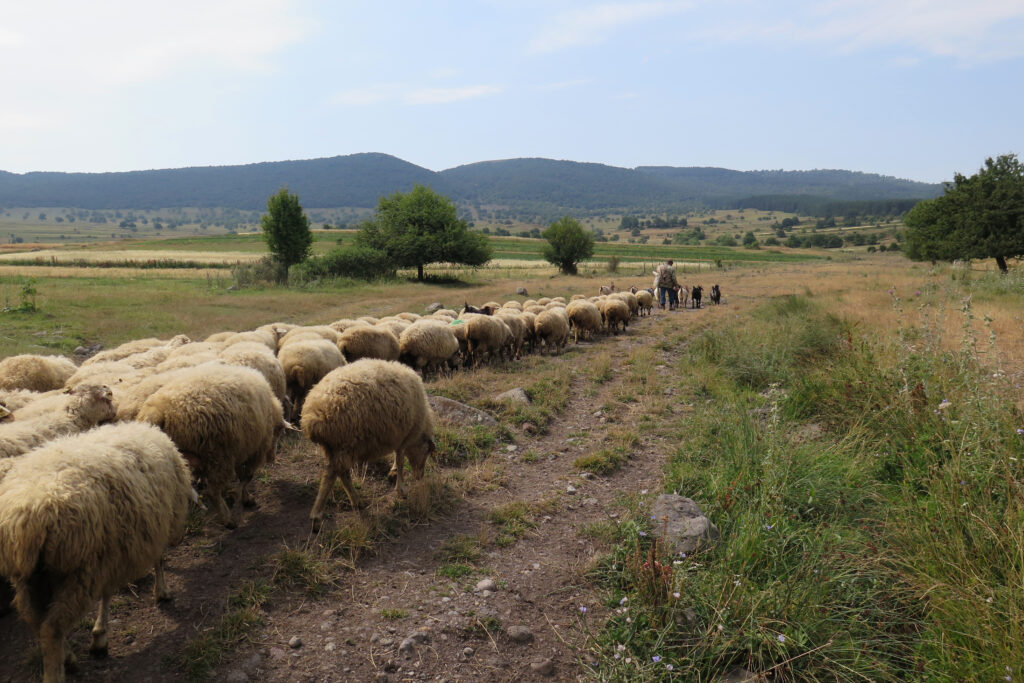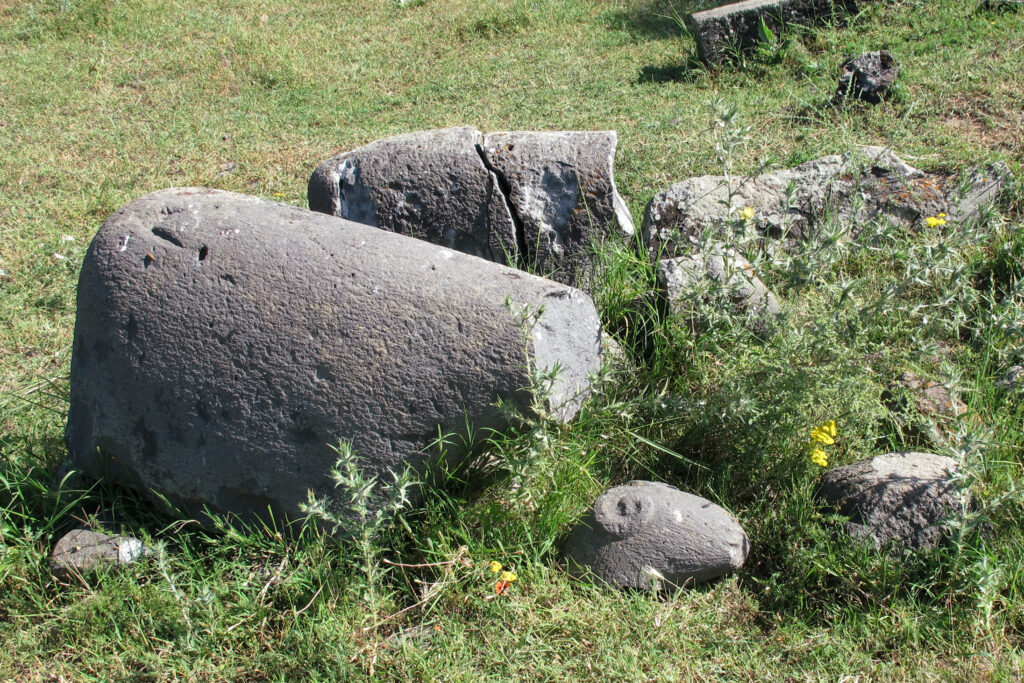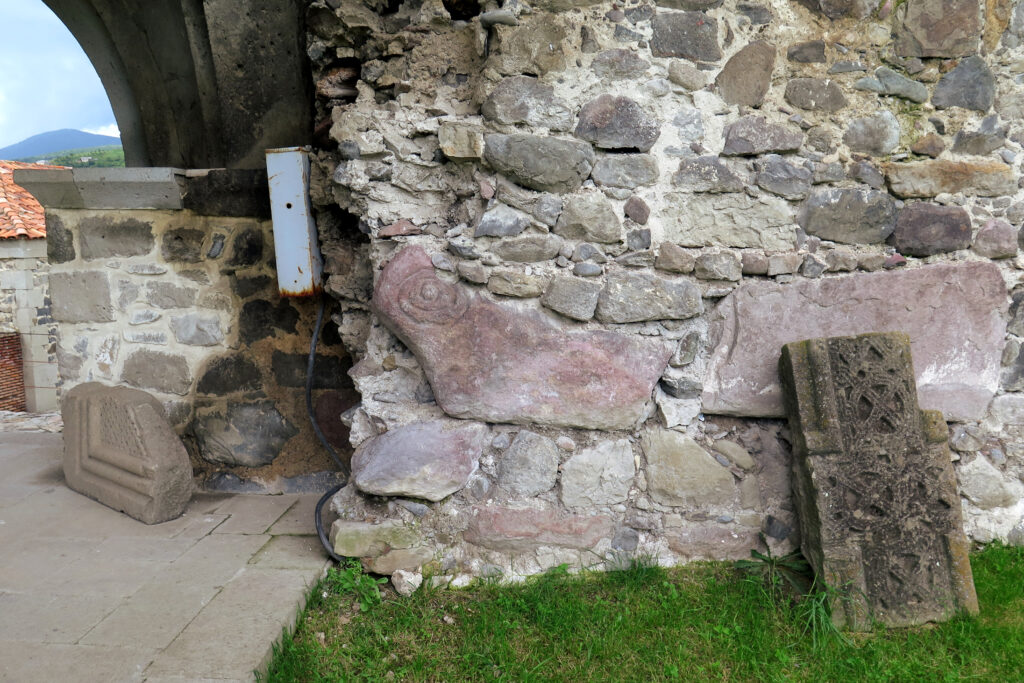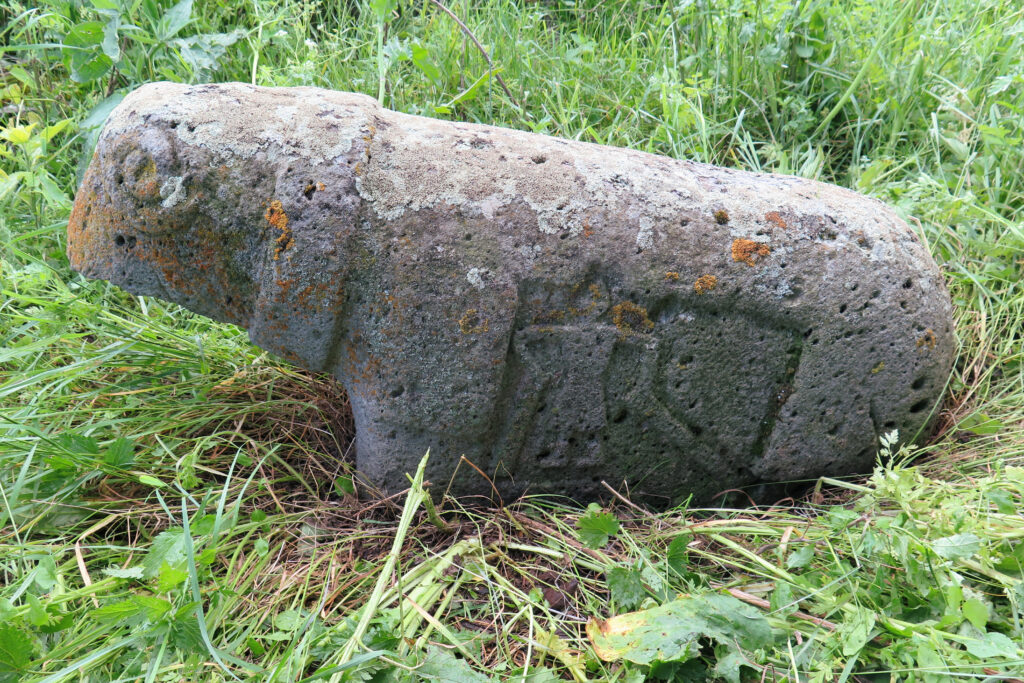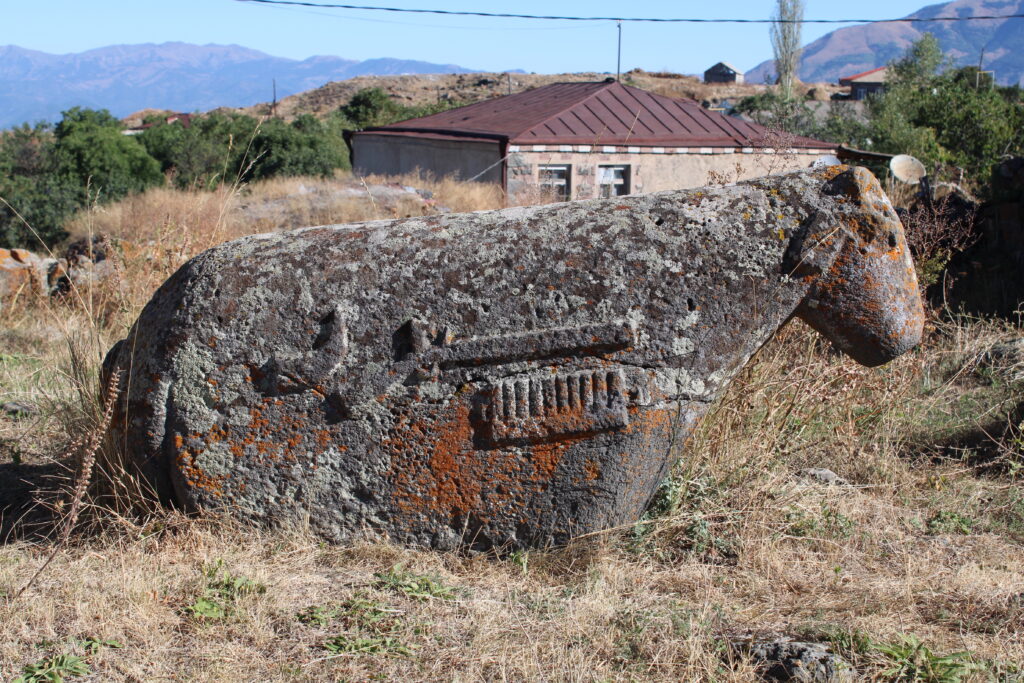How Gravestones Shaped as Sheep United the Caucasus
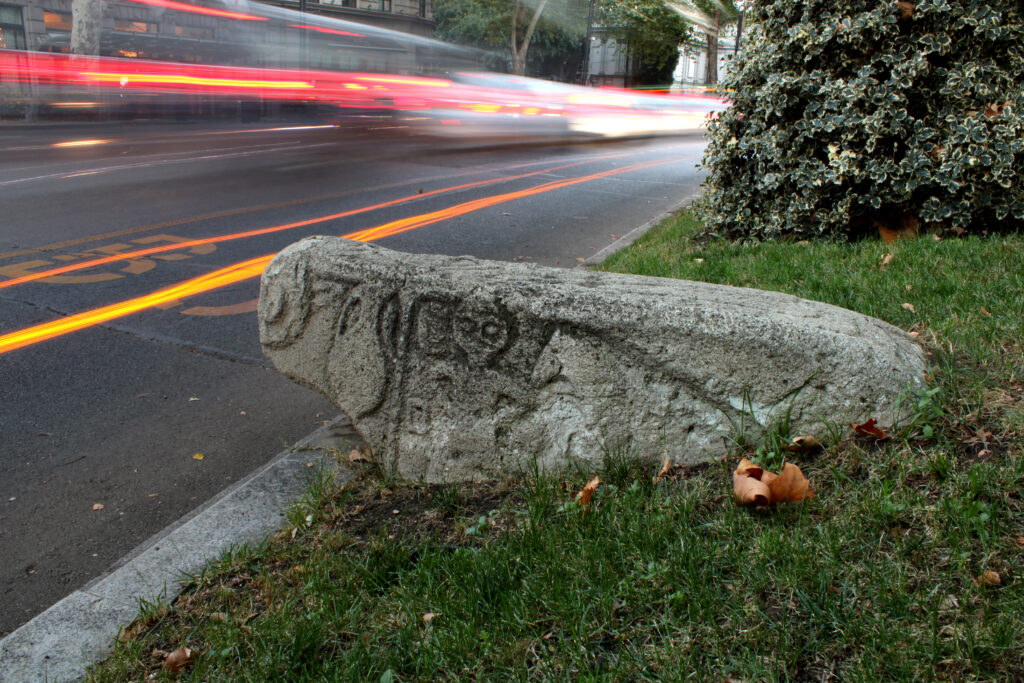
High in the Erusheti Mountains of southwest Georgia, rounded stone humps protrude from the tall grass of an untended churchyard. As we peer beneath the vegetation, we see a ram carved in coarse basalt, with a pointed head, stylized horns, and words and images engraved into its flank. It is a gravestone. We ask the parish priest’s permission to clear the area around the graves. Our host cuts the grass with his scythe and sickle, allowing us to take notes, measurements, photographs, and drawings.
This was the first of many ram-shaped gravestones we documented for the Landscape Archaeology in Georgia Project. The stones became a source of fascination for our group. Why were people memorialized with statues of lowly sheep? What did the carved symbols mean? In an age of rapid modernization, how do today’s rural populations view these monuments of their ancestors?
Raised by people of diverse ethnic, religious, and linguistic backgrounds, these stones are part of a memorial practice in the Southern Caucasus dating from the medieval period until the 19th century. Their origins have been variously assigned to Turkic, Kurdish, and Armenian forebears. But searching for progenitors can distract from what binds these peoples: their highland pastoral lifeways and the urge to be associated with the animals they reared. Sheep were the source of their livelihood, and they invested them with spiritual meaning.
Today ram-shaped stones are displayed in museums, parks, and civic spaces as antiquities, curiosities, and street furniture. But most lie forgotten in seldom-visited corners of rural graveyards. The stones are also co-opted to support nationalist and ethnocentric standpoints. They have been targets of vandalism and iconoclasm.
Yet this memorial form’s endurance demonstrates the shared interests of highland populations rather than their differences. At a time when conflicts rage across the former Soviet Union, sheep-shaped stones are an important reminder of the social and spiritual practices that transcend divisions. The rams tell a story of shared values, inscribed in Armenian, Turkish, Arabic, and Georgian script over at least 600 years.
St. GIORGI’S CHURCH, ZVELI
Sheep remain important in highland villages like Zveli, where we documented the first ram-shaped stone at St. Giorgi’s Church. In summer, flocks graze the higher pastures, known by the Turkish word yayla. At daybreak, shepherds and working dogs herd the sheep uphill along steep, dusty drove roads. They return each day at dusk. Shepherds also relocate their livestock to the yayla for longer stretches, a practice known as transhumant pastoralism. These semi-nomadic movements mark daily and seasonal cycles while maintaining pastoral farming practices that have persisted for millennia.
But much has changed in those millennia.
The inscription on the ram-shaped gravestone at St. Giorgi’s Church commemorates Ivane Zedginidze, who died on June 1, 1854. Three objects are carved into the sheep’s side: a rifle, a belt of cartridges, and a gunpowder horn. There is something incongruous about the date and accoutrements. Hewn from volcanic rock, the ram has an elemental quality. Yet this was carved in the age of capitalism and steam engines. It is a medieval-style monument that bears a date and weapon of the modern era.
MUSKHI-ON-KURA
At a deserted settlement spanning a terraced hillside, we came across two ram-shaped stones that had recently been vandalized. Both were decapitated. One was peppered with hammer marks. The fractures formed light-gray wounds against the charcoal-colored patina. An inscription on one ram reads: “Beneath this stone rests Maksa and Kato Okromeldze.”
What motivated this destruction? Was it some long-running slight against the Okromeldze family? Was it because of what this place and its long-deceased residents represented? Or was it the erroneous superstition that gold is encased in ancient carved stones? Could it be poverty or greed, not feud or intolerance, that motivated people to take hammers to these rams?
Ram-shaped stones have been destroyed on a far greater scale than this. They have also been co-opted into culture wars regarding their origins, often nationalistic claims for ethnic exclusivity. In 2005, Iran’s Armenian Prelate, Bishop Nshan Topouzian, wept while he watched helplessly from across the Araxes River as Azerbaijani soldiers swung sledgehammers and dumped ornately carved rams and cross slabs (khachkars) into the river at Julfa cemetery in Nakhchivan on the Azerbaijan-Iran border.
Whether attributed to ignorance or intolerance, the modern-day desecration of gravestones is at odds with the common concerns that unify diverse communities in the South Caucasus highlands.
AKHALTSIKHE RABATI
Looming over Akhaltsikhe, the Rabati is a clash of castellations, battlements, towers, and flags. This folly was built in 2012 over crumbling structures accumulating since the ninth century. The building works, under the aegis of then-President Mikheil Saakashvili, reportedly took barely a year to complete at a relatively meager cost, replacing assorted ruins with a simulacrum to entice tourists and prestige to this border town.
Against the inside of the gateway tower, a ram of pinkish stone is set into the masonry at a quirky angle. Displayed nearby is a row of rams, but this one is locked into the wall, as if it had fatally strayed from the flock during construction.
The ram in the wall, and other hastily incorporated building materials, are emblematic of the tragedy and farce of the Rabati’s development. Yet it may be viewed another way—as expressing a reinvented national identity, a nod to the continuity of pastoralism as the region emerged from Soviet rule.
Many Georgian historic buildings are being restored, especially churches, which gained renewed importance in the post-Soviet order. In the highland village of Kheoti, a small monastic complex has undergone an imaginative but sensitive reworking. High on the exquisite, late medieval bell tower, a ram head that was once part of a gravestone has been inserted into the wall, peering out like a gargoyle.
ERKOTA
Beside the dilapidated church at Erkota, a hamlet high above the Mtkvari River valley, stands a stocky ram. On its side is carved a figure with a curiously pointed head, holding oblong shapes. These may be the planks of a threshing sledge used to separate cereal from straw. In surveyed fields, we found andesite threshing stones with distinctive wear from repeated usage. The persistence of manual threshing and a stone-knapping tradition show the continuity of ancient practices in the age of mechanized agriculture.
Our team has recorded rams decorated with a hunter’s kit. Another ram has the hammer and tongs of a blacksmith. If these images represent the occupations of the deceased, the Erkota ram may have belonged to a crop farmer. Yet the ram is a distinctly pastoral signifier. This duality, in a location at the transitional zone between the sown fields of the valley and the grassland of the yayla, captures the essence of agropastoral practices.
In contrast to the religious themes on earlier ram-shaped stones, such as the 16th-century examples at Julfa cemetery, these 19th-century rams bear ostensibly materialist and secular symbols. Do these possessions only represent people’s pursuits, or do they have spiritual connotations? What did these later rams and their carved symbols mean to those who commissioned and displayed them?
ZVELI CEMETERY
In Zveli’s main cemetery, ram-shaped stones stand alongside memorials dating from the mid-19th century to the present. Many modern gravestones are slabs of polished stone with photorealist depictions of the deceased etched into the surface.
This contrasts with the motifs on ram-shaped stones illustrating people’s actions through the objects they used. The shift seems to capture a change from collective to more individualized depictions of personhood, perhaps reflecting the country’s emergence from Soviet rule and absorption into the capitalist sphere.
The rounded, organic rams also differ from other 19th-century memorials—straight-edged slabs, pillars, or obelisks in a more “European” style. Was this choice a reflection of class or occupation, of social status and affiliation, or just a matter of taste? Whether intended or not, there is a stylistic opposition between the vernacular and the cosmopolitan.
Commemorating people through ram-shaped stones was plausibly a conscious alignment with the values of agropastoral practice in the face of internationalism and mechanization. This memorial form demonstrates pride in the persistence of traditional highland practices, the resilience of farming strategies at times of radical change and uncertainty, and the enduring, shared interests of highland populations in the Caucasus region.































